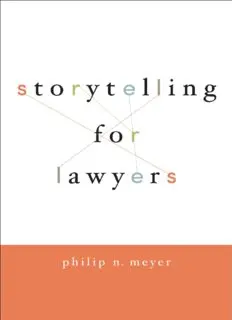
Storytelling for Lawyers PDF
Preview Storytelling for Lawyers
Storytelling for Lawyers STORYTELLING FOR LAWYERS PHILIP N. MEYER Oxford University Press is a department of the University of Oxford. It furthers the University’s objective of excellence in research, scholarship, and education by publishing worldwide. Oxford New York Auckland Cape Town Dar es Salaam Hong Kong Karachi Kuala Lumpur Madrid Melbourne Mexico City Nairobi New Delhi Shanghai Taipei Toronto With offices in Argentina Austria Brazil Chile Czech Republic France Greece Guatemala Hungary Italy Japan Poland Portugal Singapore South Korea Switzerland Thailand Turkey Ukraine Vietnam Oxford is a registered trademark of Oxford University Press in the UK and certain other countries. Published in the United States of America by Oxford University Press 198 Madison Avenue, New York, NY 10016 © Oxford University Press 2014 All rights reserved. No part of this publication may be reproduced, stored in a retrieval system, or transmitted, in any form or by any means, without the prior permission in writing of Oxford University Press, or as expressly permitted by law, by license, or under terms agreed with the appropriate reproduction rights organization. Inquiries concerning reproduction outside the scope of the above should be sent to the Rights Department, Oxford University Press, at the address above. You must not circulate this work in any other form and you must impose this same condition on any acquirer. CIP data is on file at the Library of Congress. ISBN 978-0-19539663-8 (paperback) ISBN 978-0-19-539662-1 (hardback) 1 3 5 7 9 8 6 4 2 Printed in the United States of America on acid-free paper For Anthony G. Amsterdam, with gratitude and admiration. For my family, with love. Contents Acknowledgment 1. Introduction I. Lawyers Are Storytellers II. Legal Arguments Are Stories in Disguise III. The Parts of a Story IV. Movies and Closing Arguments 2. Plotting I: The Basics I. What Is Plot? II. Plot Structure in Two Movies 3. Plotting II: Plot Structure in a Closing Argument to a Jury in a Complex Torts Case I. The “Backstory” II. Annotated Excerpts from Gerry Spence’s Closing Argument on Behalf of Karen Silkwood III. Concluding Observations 4. Character Lessons: Character, Character Development, and Characterization I. Introduction: Why Emphasize Movie Characters in Legal Storytelling? II. What Is Character, and Why Is It Important to Legal Storytellers? III. Flat and Round Characters and Static and Changing Characters —High Noon Revisited IV. Techniques of Character Development and Characterization: Excerpts from Tobias Wolff’s This Boy’s Life 5. Characters, Character Development, and Characterization in a Closing Argument to a Jury in a Complex Criminal Case I. The “Backstory” II. Annotated Excerpts from Jeremiah Donovan’s Closing Argument on Behalf of Louis Failla III. Concluding Observations 6. Style Matters: How to Use Voice, Point of View, Details and Images, Rhythms of Language, Scene and Summary, and Quotations and Transcripts in Effective Legal Storytelling I. Backstory: Grading Law School Examinations II. Preliminary Note: “Voice” and “Style” III. Voice and Rhythm: “Staying on the Surface” IV. The Use of Scene and Summary: “Showing and Telling” V. Telling in Different Voices VI. Perspective or Point of View VII. Several Functions of Perspective: How Does Perspective (Point of View) Work, and What Work Does It Do? VIII. Concluding Observations 7. A Sense of Place: Settings, Descriptions, and Environments I. Introduction II. Dangerous Territory: Contrasting Settings Evoking Danger and Instability in Joan Didion’s “The White Album” and the Judicial Opinion in a Rape Case III. More Dangerous Places Where Bad Things Happen: Use of Physical Descriptions and Factual Details to Create Complex Environments in W. G. Sebald’s The Emigrants and the Petitioners’ Briefs in Two Coerced Confession Cases IV. Settings and Environment as Villains and Villainy in the Mitigation Stories of Kathryn Harrison’s While They Slept and the Petitioner’s Brief in Eddings v. Oklahoma V. Concluding Observations 8. Narrative Time: A Brief Exploration I. Introduction II. The Ordering of Discourse Time III. Concluding Observations 9. Final Observations: Beginnings and Endings Notes Index Acknowledgment FROM 2003 THROUGH 2008 I collaborated with Anthony G. Amsterdam preparing instructional materials for the Narrative Persuasion Institute. In this book I draw on these materials. I am grateful to Tony for his encouragement and support enabling me to write this book.
